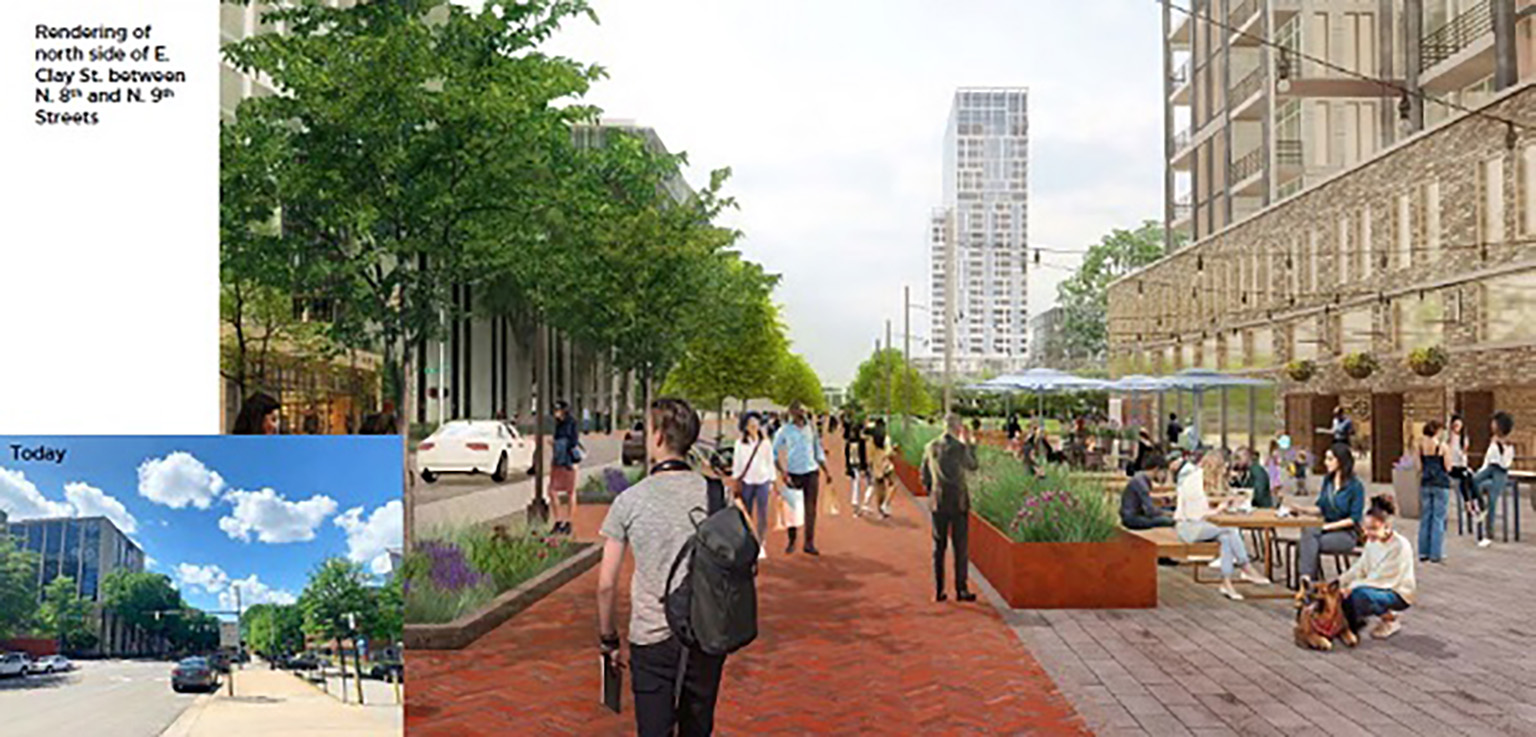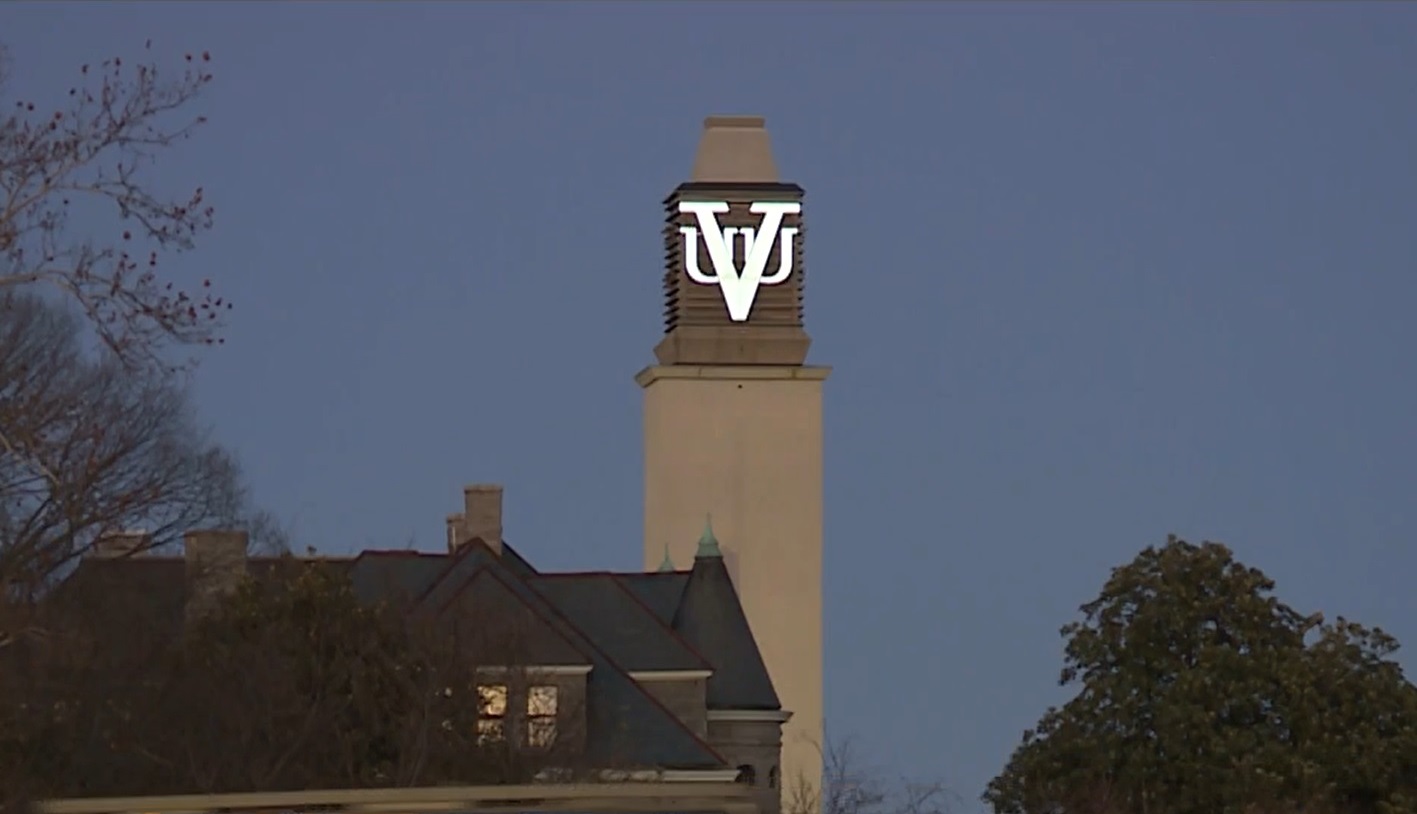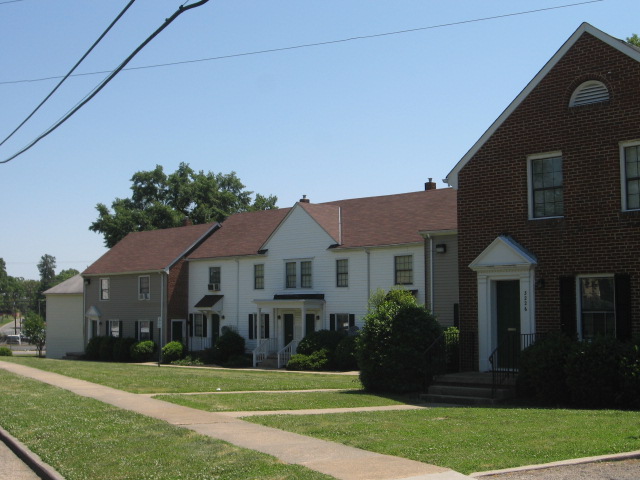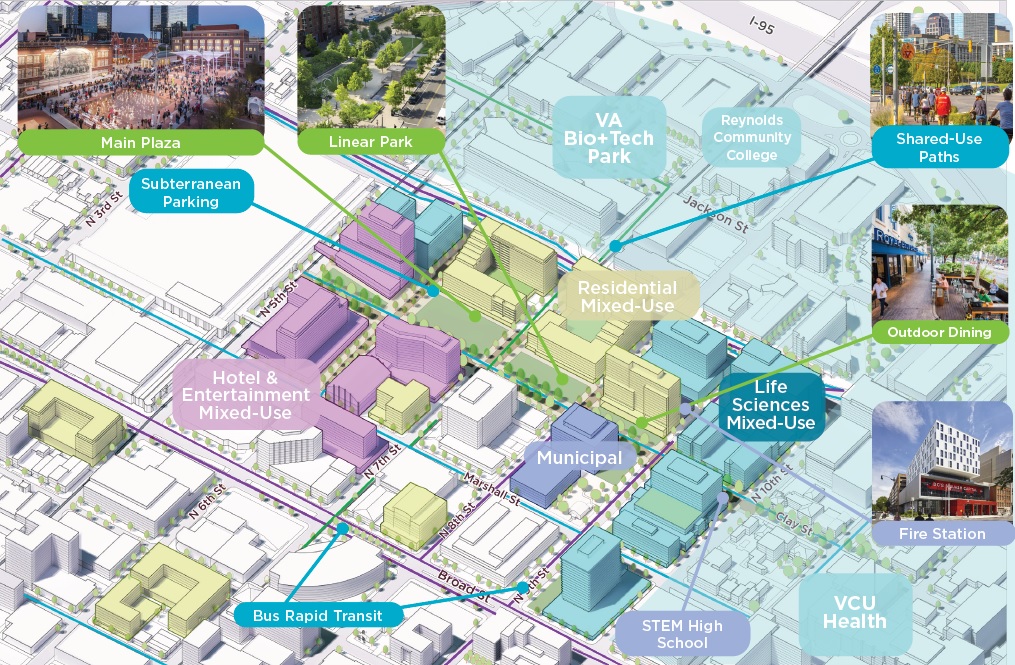
A rendering of how development could look facing north from Clay Street between Eighth and Ninth streets under the city’s City Center plan. (Images courtesy of the City of Richmond)
A major step forward in the potential redevelopment of a swath of downtown was taken without fanfare at Monday’s Richmond City Council meeting, while a controversial signage issue also was voted on with no discussion.
The council approved a city-initiated rezoning of the 20-block City Center area that includes the shuttered Richmond Coliseum. The approval was included in the council’s consent agenda, typically voted on en masse without discussion among members.
The 26-acre area, called the City Center Innovation District, also is anchored by the VA Bio+Tech Park and VCU Health and is generally north of East Broad Street, south and west of interstates 64 and 95 and east of North Third Street.
The zoning changes tee up the Coliseum’s demolition and redefine the area as a so-called innovation district, aimed at encouraging development that would feed off and enhance the biotech park and health system. The changes follow recommendations of the adopted City Center Innovation District Small Area Plan, which the council approved in February.
The rezoning also sets the stage for expected solicitations for the sale and redevelopment of the Coliseum site and other city-owned properties, which make up the bulk of the area.
Specifically, the city’s Economic Development Authority is preparing a joint solicitation that it plans to issue with the Greater Richmond Convention Center Authority to gauge development interest in a 9-acre assemblage that includes the arena property and the site of a long-sought convention center hotel.
Planned to go out this fall, the request for interest also would include the neighboring Blues Armory building and adjoining properties that once made up the old Sixth Street Marketplace. Those properties are being included following a resolution by the Richmond Redevelopment & Housing Authority to transfer their ownership to the EDA, as the city did in May with the Coliseum.
The rezoning was originally planned to consolidate existing designations into a new “innovation” zoning category that would allow for a greater mix of uses, including residential uses and street-fronting commercial spaces.
Staff ultimately recommended to instead revise the existing Research Park zoning district to allow for those uses as well as hotel and school use, unlimited building height with required step-backs, unlimited density, and scale and design guidelines in accordance with the area plan. The district was also expanded to include properties beyond the biotech park.
Previous zoning in City Center was primarily B-4 Central Business District, RO-3 Residential-Office District and zoning specific to the Coliseum, the biotech park and the convention center.
VUU sign appeal granted

One of the illuminated logo signs on Virginia Union University’s Belgian Building. (Courtesy of WTVR)
In the regular agenda portion of the meeting, councilmembers voted to grant an appeal from Virginia Union University that reverses a decision of the city’s Commission of Architectural Review and awards a certificate of appropriateness for four illuminated “VUU” logo signs the university placed atop its campus bell tower.
The signs were placed in late 2019 without required approvals from the city, which is looking at how to permit the signs after the fact. The signs also violated a preservation easement that VUU established in 2010 with the Virginia Department of Historic Resources, which is finalizing an agreement to keep the signs up while mitigating their placement on the 1930s-era tower, which is considered architecturally significant.
VUU’s agreement with the state Board of Historic Resources includes an annual payment of $35,000 that the university would be required to pay every year that the signs remain up.
The unanimous council vote was made without any comment from members or in a preceding public hearing, and approved a resolution introduced by Ann-Frances Lambert, whose Third District includes the university.
At a committee meeting the previous week, Lambert noted that the signs are already installed and called the resolution “an exception to the rule” and “for the greater of the public good.”
In addition to the certificate, the city also requires a special-use permit to allow the sign’s size, which exceeds what’s allowed in institutionally zoned districts, as well as sign and electrical permits that hinge on the certificate’s award. An ordinance to award the SUP also was on the agenda but was continued to the Oct. 10 meeting.
Other provisions of VUU’s agreement with DHR include regular structural monitoring, highway markers informing the public about the structure’s history, and a preservation plan for the historically recognized campus.
The agreement remained unsigned as of Wednesday. DHR Director Julie Langan said she expects to sign the agreement by the end of this week.
The 165-foot tower and adjoining Belgian Building were originally a pavilion designed by a noted Belgian architect for Belgium’s entry in the 1939 New York World’s Fair. The complex was awarded to VUU over other competing U.S. universities when Belgium offered it due to the Nazi invasion of the country during World War II.
A fundraising effort led by VUU produced the $500,000 needed to relocate the complex. In 2019, VUU received a $500,000 grant from the National Parks Service, through its African American Civil Rights Grant Program, to restore and renovate the Belgian Building. DHR was to be involved in that project to ensure compliance with the preservation easement.
RRHA bond approvals expedited

The 112-unit South Gate Apartments at 3448½ Maury St. are slated for a multimillion-dollar rehab. (City of Richmond photo)
Also Monday, the council expedited and approved requests from the Richmond Redevelopment & Housing Authority to issue multifamily housing revenue bonds for renovations or improvements to four privately owned properties that provide income-based housing.
The requests were added to the agenda that evening because RRHA needs to apply for a bond volume cap allocation from the state and close on the bonds this year, according to accompanying staff reports. The allocation is awarded on a first-come, first-served basis and is competitive with other localities.
The bond amounts include $15 million each for the 121-unit Guardian Place I Apartments at 1620 N. Hamilton St. and the adjacent, 115-unit Guardian Place II Apartments at 3840 Mastin Lane. Bonds for the 161-unit, 49-building Townes at River South Apartments at E. Ninth and Everett streets total $14.3 million.
And $10 million in bonds are for the 112-unit, 14-building South Gate Apartments at E. 36th and Maury streets. South Gate is one of three apartment rehabs undertaken in recent years by local developer Genesis Properties.
Correction: The four properties involved with the RRHA bonds are privately owned. An earlier version of the story incorrectly described their ownership.

A rendering of how development could look facing north from Clay Street between Eighth and Ninth streets under the city’s City Center plan. (Images courtesy of the City of Richmond)
A major step forward in the potential redevelopment of a swath of downtown was taken without fanfare at Monday’s Richmond City Council meeting, while a controversial signage issue also was voted on with no discussion.
The council approved a city-initiated rezoning of the 20-block City Center area that includes the shuttered Richmond Coliseum. The approval was included in the council’s consent agenda, typically voted on en masse without discussion among members.
The 26-acre area, called the City Center Innovation District, also is anchored by the VA Bio+Tech Park and VCU Health and is generally north of East Broad Street, south and west of interstates 64 and 95 and east of North Third Street.
The zoning changes tee up the Coliseum’s demolition and redefine the area as a so-called innovation district, aimed at encouraging development that would feed off and enhance the biotech park and health system. The changes follow recommendations of the adopted City Center Innovation District Small Area Plan, which the council approved in February.
The rezoning also sets the stage for expected solicitations for the sale and redevelopment of the Coliseum site and other city-owned properties, which make up the bulk of the area.
Specifically, the city’s Economic Development Authority is preparing a joint solicitation that it plans to issue with the Greater Richmond Convention Center Authority to gauge development interest in a 9-acre assemblage that includes the arena property and the site of a long-sought convention center hotel.
Planned to go out this fall, the request for interest also would include the neighboring Blues Armory building and adjoining properties that once made up the old Sixth Street Marketplace. Those properties are being included following a resolution by the Richmond Redevelopment & Housing Authority to transfer their ownership to the EDA, as the city did in May with the Coliseum.
The rezoning was originally planned to consolidate existing designations into a new “innovation” zoning category that would allow for a greater mix of uses, including residential uses and street-fronting commercial spaces.
Staff ultimately recommended to instead revise the existing Research Park zoning district to allow for those uses as well as hotel and school use, unlimited building height with required step-backs, unlimited density, and scale and design guidelines in accordance with the area plan. The district was also expanded to include properties beyond the biotech park.
Previous zoning in City Center was primarily B-4 Central Business District, RO-3 Residential-Office District and zoning specific to the Coliseum, the biotech park and the convention center.
VUU sign appeal granted

One of the illuminated logo signs on Virginia Union University’s Belgian Building. (Courtesy of WTVR)
In the regular agenda portion of the meeting, councilmembers voted to grant an appeal from Virginia Union University that reverses a decision of the city’s Commission of Architectural Review and awards a certificate of appropriateness for four illuminated “VUU” logo signs the university placed atop its campus bell tower.
The signs were placed in late 2019 without required approvals from the city, which is looking at how to permit the signs after the fact. The signs also violated a preservation easement that VUU established in 2010 with the Virginia Department of Historic Resources, which is finalizing an agreement to keep the signs up while mitigating their placement on the 1930s-era tower, which is considered architecturally significant.
VUU’s agreement with the state Board of Historic Resources includes an annual payment of $35,000 that the university would be required to pay every year that the signs remain up.
The unanimous council vote was made without any comment from members or in a preceding public hearing, and approved a resolution introduced by Ann-Frances Lambert, whose Third District includes the university.
At a committee meeting the previous week, Lambert noted that the signs are already installed and called the resolution “an exception to the rule” and “for the greater of the public good.”
In addition to the certificate, the city also requires a special-use permit to allow the sign’s size, which exceeds what’s allowed in institutionally zoned districts, as well as sign and electrical permits that hinge on the certificate’s award. An ordinance to award the SUP also was on the agenda but was continued to the Oct. 10 meeting.
Other provisions of VUU’s agreement with DHR include regular structural monitoring, highway markers informing the public about the structure’s history, and a preservation plan for the historically recognized campus.
The agreement remained unsigned as of Wednesday. DHR Director Julie Langan said she expects to sign the agreement by the end of this week.
The 165-foot tower and adjoining Belgian Building were originally a pavilion designed by a noted Belgian architect for Belgium’s entry in the 1939 New York World’s Fair. The complex was awarded to VUU over other competing U.S. universities when Belgium offered it due to the Nazi invasion of the country during World War II.
A fundraising effort led by VUU produced the $500,000 needed to relocate the complex. In 2019, VUU received a $500,000 grant from the National Parks Service, through its African American Civil Rights Grant Program, to restore and renovate the Belgian Building. DHR was to be involved in that project to ensure compliance with the preservation easement.
RRHA bond approvals expedited

The 112-unit South Gate Apartments at 3448½ Maury St. are slated for a multimillion-dollar rehab. (City of Richmond photo)
Also Monday, the council expedited and approved requests from the Richmond Redevelopment & Housing Authority to issue multifamily housing revenue bonds for renovations or improvements to four privately owned properties that provide income-based housing.
The requests were added to the agenda that evening because RRHA needs to apply for a bond volume cap allocation from the state and close on the bonds this year, according to accompanying staff reports. The allocation is awarded on a first-come, first-served basis and is competitive with other localities.
The bond amounts include $15 million each for the 121-unit Guardian Place I Apartments at 1620 N. Hamilton St. and the adjacent, 115-unit Guardian Place II Apartments at 3840 Mastin Lane. Bonds for the 161-unit, 49-building Townes at River South Apartments at E. Ninth and Everett streets total $14.3 million.
And $10 million in bonds are for the 112-unit, 14-building South Gate Apartments at E. 36th and Maury streets. South Gate is one of three apartment rehabs undertaken in recent years by local developer Genesis Properties.
Correction: The four properties involved with the RRHA bonds are privately owned. An earlier version of the story incorrectly described their ownership.

Good news on both fronts. Reality always wins, eventually — like gravity and entropy and water. I LIKE the VUU emblem on the tower — makes it more interesting and iconic looking — and, if VUU is ever to become a “Real School” again like it once was in the post-desegregation era, one of the things it will need is the freedom to be innovative and independent. Right now, I am not sure what the value proposition of VUU is other than “they let me in and the government will loan my money to go there. Downvotes and specific disagreements… Read more »
I would love to see this all happen, but offer two thoughts. First, don’t make the project so big that it ends up not happening. Things thrive best when you have multiple entrepreneurs instead of one master-planned development. It assures that what you put in there is actually meeting a need instead of just looking nice on the drawing board. Also, it looks like they have buildings slated on what is now the courthouse surface parking lot. That parking would have to be replaced somewhere.
“ It assures that what you put in there is actually meeting a need instead of just looking nice on the drawing board.” Thank you for this brilliance that sounds just like common sense. We’re not Louis XIV here!
“Also, it looks like they have buildings slated on what is now the courthouse surface parking lot. That parking would have to be replaced somewhere.”
With the Coliseum shuttered, there are now plenty of underutilized parking decks in the area, especially the 7th street one already used by the courts.
Article mentions, “unlimited building height with required step-backs, unlimited density, and scale and design guidelines in accordance with the area plan.”
The tower in the City Center rendering appears to be 30+ stories tall which is more than any other building downtown.
We can only hope that Richmond finally breaks the 30 floor mark and start building more and more vertical!